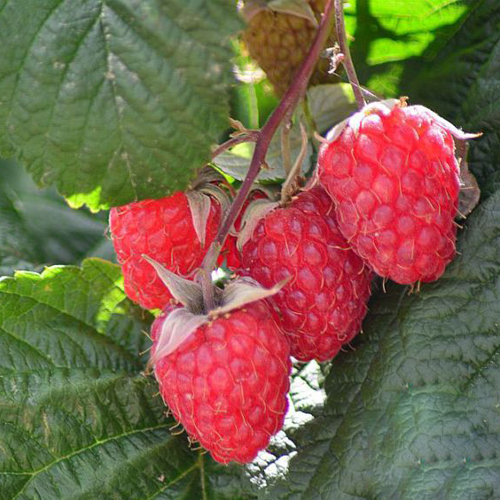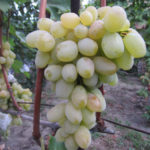Raspberry variety Volnitsa
Volnitsa is a domestic raspberry variety that, over the decades since its inception, has won the trust of many gardeners thanks to a significant number of its positive qualities and a modest list of disadvantages. It was bred on the basis of the Kokinsky stronghold of the All-Russian Selection and Technological Institute of Horticulture and Nursery (VSTISP) - the leading scientific institution of our country specializing in raspberry breeding. The famous scientist, world-renowned researcher, professor and academician of the Russian Academy of Agricultural Sciences Ivan Vasilyevich Kazakov had a hand in the creation of the variety. Svetlana Dmitrievna Aitzhanova and Vera Lavrentievna Kulagina worked in co-authorship with him on the novelty. During hybridization, they chose Kazakov's varieties of the previous generation as a parental pair - Brigantine and Bryanskaya, from which Volnitsa inherited many remarkable characteristics.

So, our heroine is distinguished by such advantages as unpretentiousness, high winter hardiness, good resistance to fungal diseases, decent yield, excellent taste and aroma of ripe fruits, as well as exceptional versatility of their use. But, at the same time, it cannot be called an ideal raspberry, tk. some flaws in agrobiology set off existing advantages. First of all, this concerns certain difficulties with harvesting due to the relatively strong attachment of the berries to the fruit. In addition, the bushes are not resistant to damage by some pests, but this problem is easily solved by using plant protection chemicals.
In total, the properties that the variety possesses allowed it, after long 13 years of variety testing, to be officially included in the State Register of Breeding Achievements of the Russian Federation in 2007. Raspberries were recommended for cultivation in the North-West and Central regions of the European part of our country, however, by amateur gardeners long before that it was widespread in various parts of Russia, and also proved to be good in Ukraine and Belarus. This fact allows us to talk about another positive factor - the high plasticity of the variety, thanks to which plants are able to easily adapt to a wide variety of soil and climatic conditions.
Agrobiological characteristics
The growth vigor of raspberry bushes is average. Their appearance is spreading, the height is from one and a half to two meters. The stems of medium thickness definitely need a garter to the supports or trellises, because under the influence of the wind, they can become tangled or damaged, and under the weight of the crop, they can lie on the ground. Shoot-forming ability of Wolnitsa is moderate. Each adult plant grows up to 6-8 replacement stems annually. In the first year of life, these shoots are not pubescent and weakly spiny, but covered with a layer of waxy bloom and painted brown. As they mature, they change their color to light brown, which they retain in the coming season. Spines on biennial stems are dark purple, straight, medium in height and somewhat dull. They are distributed evenly along the entire length of the shoot. However, their presence does not cause significant difficulties when caring for raspberry bushes. The plant foliage is quite high. By their type, the leaves are complex, consisting of several simple leaves, connected by powerful rich green petioles, on which small spurs may also be present. The leaf blades of the variety themselves are quite large, wrinkled in texture, not pubescent, dark green with noticeably outlined veins. The shape of the leaf is oval-pointed, the profile is medium twisted, there is a low sawtooth serration along the perimeter. The number of laterals formed on each shoot reaches 12 pieces, and they, as a rule, are long, well-branched, as a result of which each of them is capable of carrying about 15-20 ovaries.The strength of the attachment of fruit twigs to the stem is sufficient, and they do not need additional garters. The growth activity of the root shoots in the bushes is low, which makes it possible to easily keep the raspberry in a neat condition in the area that was originally allotted to it. At the same time, one should not expect rapid reproduction of raspberries due to the appearance of numerous offspring.

Volnitsa is one of the mid-ripening non-renovated varieties in which fruiting occurs on the shoots of the second year of life. Mass flowering occurs in the first half of May, and the fruits ripen by the end of June. The yield of the harvest is much more amicable than the remontant varieties, and a few weeks after the appearance of the first ripe berries, the main harvest is completed. The productivity of plants with decent care and a high level of agricultural technology can be very significant, reaching 3-4 kg. However, due to the spreading shape of the bushes and the associated need for a discharged planting, the yield per unit area is rather modest, and, according to information from various sources, ranges from 35-40 to 110-115 c / ha. The wide range of productivity assessments is obviously associated with the significant influence of the conditions in which raspberries are cultivated on the volume of their harvests.
Ripe berries have an attractive appearance, a classic conical shape with a blunt tip, average size, and a weight of about 3.5-4 grams. The fruits for the most part are distinguished by good evenness, due to which, when assembled, they look especially elegant. Their surface is shiny and covered with hardly noticeable sparse hairs. The color is bright red. The drupes are medium in size, very well welded together, and therefore the berries of this variety do not fall apart even with significant mechanical stress. They are also firmly attached to the fruit, do not crumble even when overripe, and in an insufficiently mature form do not separate at all. The flesh of the fruit is firm, sweet and sour in taste, fragrant thanks to the intense aroma typical of the culture. Biochemical analysis of fruits shows a high total dry matter content - up to 15% and sugars - up to 8-9%. The titratable acidity is also not too low - in the range of 1.5-1.6%, in connection with which the sugar-acid index is 5-6 units. Vitamin C is found in amounts of 25-35 mg per 100 grams of raspberries. The seeds are small and hardly noticeable when eaten. Wolnitsa's tasting score - 4 points.
You can use the crop in a variety of ways. Remarkable gastronomic properties guarantee our heroine success when consumed fresh. On the shelves, it makes an indelible impression on customers with its excellent presentation, associated both with the initial attractiveness of the berries, and with their amazing safety when transported from field to market. The high transportability of fruits is something for which farmers respect Volnitsa very much, forgiving her even difficulties with harvesting. In processing, the variety also shows itself from a very good side. The fruits perfectly retain their integrity and shape, not only in various preservation, but also after thawing, thereby confirming their suitability for storage in a frozen state. Compotes and preserves are distinguished by their richness of taste, color and aroma, and, moreover, have a rich vitamin and mineral composition. This raspberry is also well suited for making dried fruits.
Even an inexperienced gardener who has at least a basic understanding of the agricultural technology can cope with the cultivation of the variety. Volnitsa is able to forgive its owners for many omissions, thanks to the unpretentiousness and vitality of plants. In particular, they are not afraid of frosts down to -35 ° C, and if the shoots bent to the ground are covered with snow, then a more severe cold becomes nothing to them.The main fungal diseases also do not cause significant damage to the bushes, and of the pests, the fight will only be required against the raspberry mite. There are no special problems with the choice of a place for landing, because Our heroine has no special requirements for the type and texture of the soil. Given the spreading nature of the shoots, the planting pattern for this raspberry should not be too dense. The recommended row spacing is 2-2.5 meters, and the distance between adjacent plants in a row is 1-1.5 meters. Thus, one hundred square meters of land can accommodate 30-40 bushes of our heroine.








